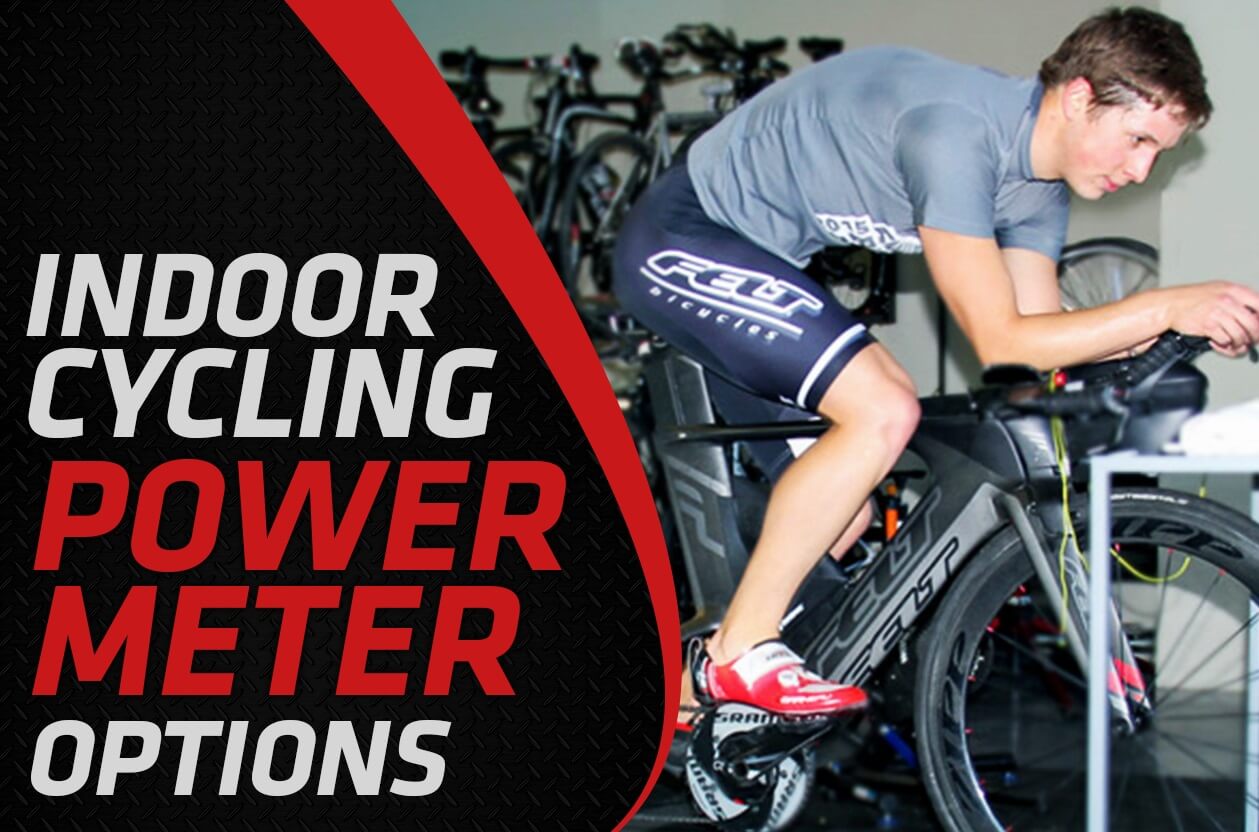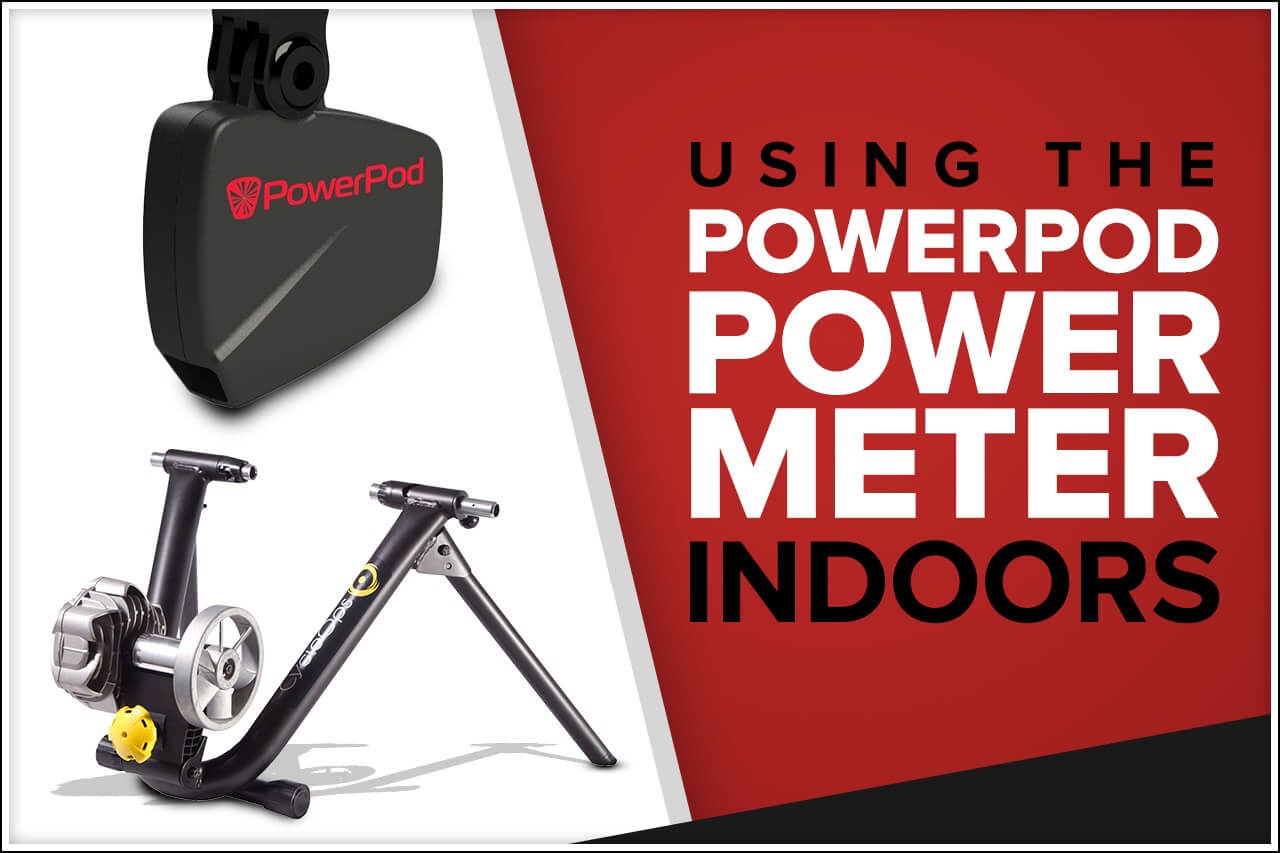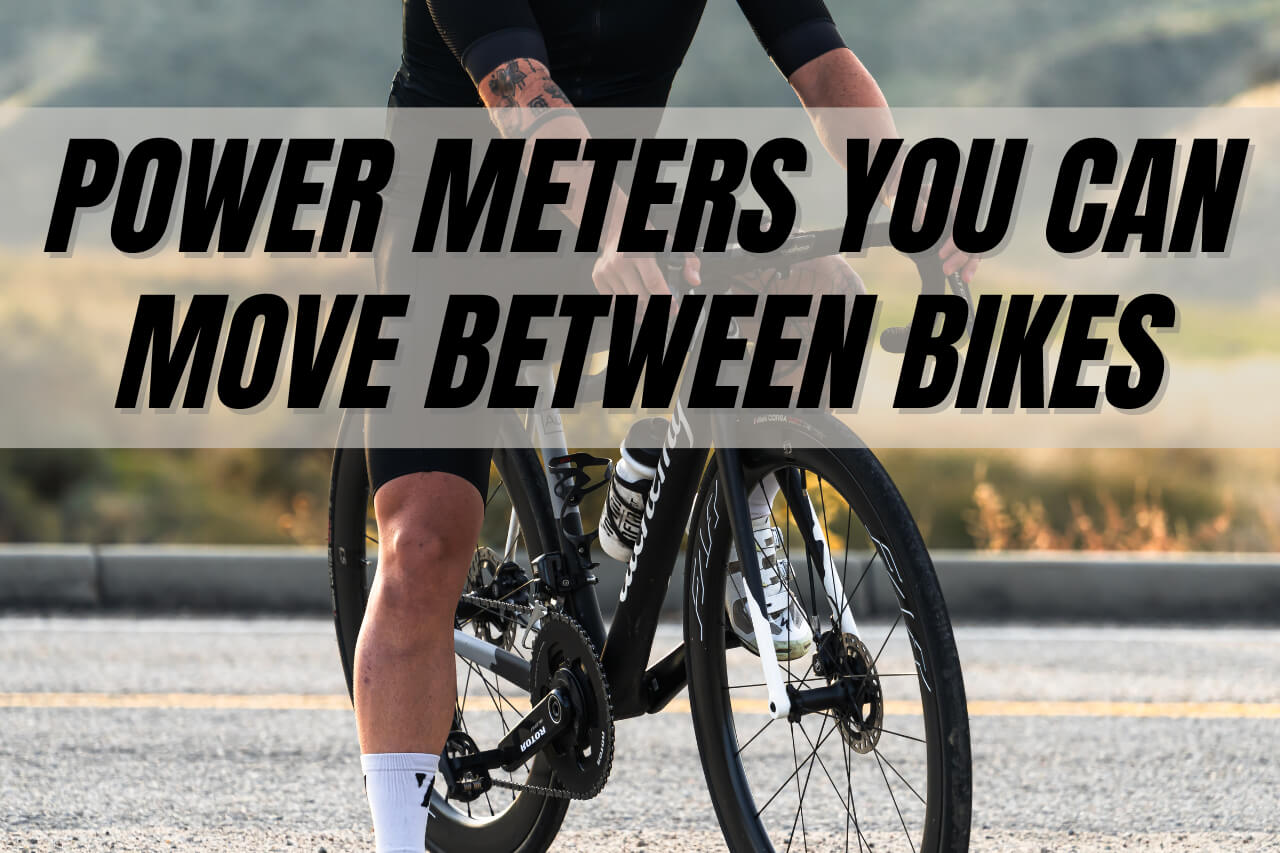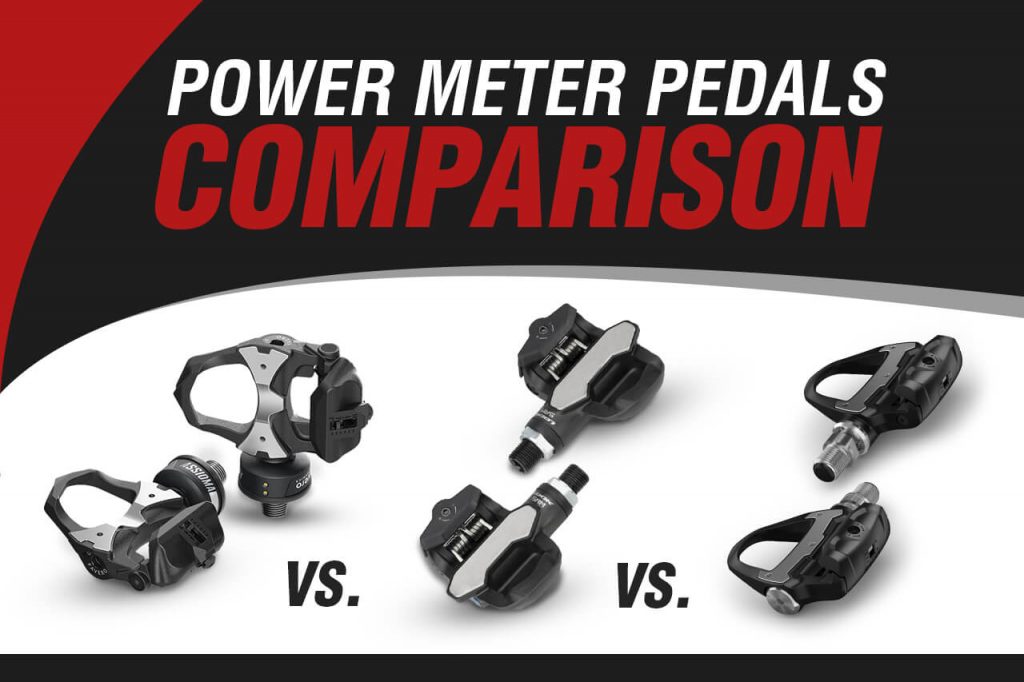Going for a ride or training session on your favorite trail or stretch of road is an experience that never seems to get old. As they say…it’s tough to beat the great outdoors. However, at Power Meter City, we are also big advocates of indoor training. In fact, indoor training offers several distinct advantages when compared to riding outside. We will touch on these below. But the real purpose of this article is to discuss what your indoor cycling power meter options are. You see, training with power when you’re indoors is just as important – if not more so – as when you are outside. Fortunately, as we’ll outline in this article, you have several indoor power meter options based on your budget and circumstances. Let’s check ’em’ out!

Advantages to Riding Indoors
So while not the main focus of this article, we wanted to touch on the reasons why we like to take advantage of indoor training.
1. Quicker start-up and finish
So if you’re time crunched like the rest of us, you’re always looking for ways to make the most of limited training time. When you ride indoors, pre- and post-ride chores are often minimized. For example, when you ride outside, you typically have to kit-up, prep your bike, and pack tools and food. Maybe you also have to load up your bike and drive to a trail. When you’re indoors, you can just hop on and ride. This is especially true if you’re fortunate enough to have a dedicated indoor bike that is already set up and ready. The same applies post-ride. Indoors, there is no clean up (ok…maybe some sweat to wipe down), no bike to wash, no drive home, etc.
2. No wasted time
Ok, this is perhaps the biggest advantage and another one that time crunched folks will enjoy. When you ride indoors, it’s the most effective use of your training time because you’re constantly working. If you ride for 60 minutes indoors, you pedal for 60 minutes. Outside, due to descents, traffic lights, mechanical failures, other riders in your group wanting to stop, etc., your actual ride time will be something less than this – and perhaps much less. On average, a 60 minute indoor ride would equal 90 minutes of riding outside. Don’t believe that? Look at your last few ride files. I think you might be surprised to see how much time you’re not actually pedaling. In addition to being more time efficient, steady state riding can also lead to improved fitness.
This of course makes the assumption that your goal for the workout is to maximize fitness. Maybe instead it’s time for a fun, group ride. If so, great. Or maybe you’re outside and for part of your ride you’re practicing descending at speed for example. While not pedaling, that is hardly wasted time. So there are some caveats here. Your goal on every ride surely isn’t to pedal start to finish. We’re just making the point that indoor training is great for maximizing limited training time.
3. Perfect intervals
This is another huge one. If you want to do intervals using your power meter (and we hope you do), an indoor workout is a great place to do them. Why? Because you can structure your workout however you want, without outside elements interfering. 5 minute intervals with 5 minute recoveries…great. How about 30 minute tempo intervals. No problem. When you’re outside, you’re at the mercy of the road or trail. You might run into a light, have to slow for another person, the road might dip or go up. Any number of factors can influence your interval. However, when you’re training with your power meter inside, you can construct perfect intervals.
One more thing…indoor workouts are repeatable. If you want to see how you improved, you can accurately compare one indoor workout to the next. Direct comparisons on outdoor workouts can be more difficult unless your route or trail is the exact same. And even then it can be influenced by factors such as wind, stops made in different places, having to slow for other riders, etc.
4. Safer at night and better for bad weather
While we actually enjoy putting the lights on the bike and getting out for a night ride now and then, there is no doubt that an indoor bike is a safer alternative, especially if you’re talking about a night ride with cars involved.
Like night rides, bad weather rides are also character builders. If you want to go for it…by all means. Having said that, an indoor ride is a beautiful thing when it gets nasty outside. As you watch the rain pound on the window…you’ll find yourself smiling inside…even despite the pain of your current interval!
Your Indoor Power Meter Options
Below, we break your indoor power meter options into four buckets, based on what equipment you currently have as well as what some of your goals might be.
1. If you already have a power meter on your bike -> Trainer
So this is perhaps the most popular and simplest of your indoor cycling power meter options. If you already have a power meter on your bike, you can simply use as your power device. The power meter can send power and cadence data to your bike computer. It can also communicate with indoor training app such as Zwift or Sufferfest, just to name a couple. The only thing you need to purchase is a trainer to use your power equipped bike on. Done deal!
Popular models
There are a ton of bike trainers to choose from. They typically start at around $300 and go up, but you can also find cheaper or used options for less. We’re big fans of the Feedback Trainers, which in addition to providing a great road feel, are super portable. Another great trainer is the Saris Fluid 2. It’s actually one of the best-selling trainers of all time and features a large, precision-balanced flywheel that provides a road-like feel.
One thing to note…
There is one important thing to note if you go this route. Many popular indoor training apps can communicate gradient changes directly to your trainer, providing a more real-world training experience. However, they can only do this if you have what is called a ‘smart trainer’ (see the next section for details). So if you go with a simple (non-smart) trainer as listed above, realize your trainer will not be able to provide this feedback. For this reason, some folks, regardless of if they have a power meter on their bike or not, will opt for a smart trainer (see below).
2. No power meter on your bike -> Smart Trainer
If you don’t currently have a power meter on your bike and you want to be riding indoors, you will need a source of power data. Enter the smart trainer. These sophisticated, but pricy, trainers will take your indoor program to the next level. To being with, they have a built-in power meter. The power meter will send both power and cadence data to your bike computer, smartphone or training app.
In addition, since the trainer measures power at the rear wheel, they will by default be measuring power from both legs…no left leg only power measurement here! But it gets better…When paired with an indoor training app, these trainers can provide feedback right to your pedals. The effects of a hill, draft, etc. are felt in real-time, just as the indoor training app would intend (also known as ERG or Ergometer mode). Basically, the trainer takes control of the resistance for you.
This also makes structured training pretty straightforward. Once an interval-type workout is programed into your training app, the smart trainer will adjust the wattage, from one interval to the next, exactly matching your workout. You just need to focus on turning the pedals!
Popular models
Smart trainers start around $500, however many of the popular models sell for $1,000 or more. One of our favorite trainers is the Saris H3 Direct Drive Smart Trainer. The H3 sells for $799 and features a really precise and responsive ERG mode. As mentioned above, this is a feature commonly used with cycling applications such as Zwift and TrainerRoad. In addition, the H3 records only 59 decibels at 20 mph! It’s nice to have a trainer that doesn’t sound like a plan taking off.
The Tacx NEO 2T Smart Bike Trainer is also a popular model, however it is the most pricey at $1,399. The NEO 2T has dynamic inertia technology which compensates for rider weight and other factors to ensure a realistic and smooth ride. In addition, it can handle sprints of up to 2,200 watts, can simulate climbs up to a 25% incline and all while measuring your power within 1.0%. Note that Tacx also makes some more affordable smart trainers. These would include the Flux 2 ($899) and Flux S ($749).
One thing to note…
While smart trainers are great, you can’t take them on a ride outside! So the one drawback to this option, is you won’t have a power meter on your bike for outdoor training rides. That’s an advantage to option #1 – you have power indoors and out. However…you don’t get the benefits of a smart trainer. There are always trade-offs!
3. Already own a spin bike -> Add power meter pedals
Some people already have an indoor spin bike they like to use, but just need power data. No problem. Power meter pedals to the rescue. Almost all spin bikes allow you to remove your current pedals and install new ones, and therefore, you could easily attach a set of power meter pedals. (Please note, these power meter pedals require the use of road cycling shoes). This is by far the quickest and easiest way to add a power meter to your spin bike.
Popular models
Our best-selling pedal is the Favero Assioma. The Assioma UNO measures power from the left leg while the Assioma DUO measures power from both legs. These pedals are priced right and are known for their accuracy and relatability. Favero also offers the PRO MX-2 and MX-1 for mountain bike and gravel riders. Both the road and off-road versions also come loaded with features such as IAV power technology, auto-zero, cycling dynamics and more.
Garmin also recently introduced its new Garmin Rally power meter pedal. The Rally comes in three versions: Rally RK (LOOK Keo cleat), RS (Shimano SPD-SL cleat) and XC (Shimano SPD cleat). Garmin power meters feature an ultra-slim pedal body (road versions), Bluetooth SMART, easy set-up and Garmin’s Cycling Dynamics pedaling metrics.
4. Smart Bike
This last option is the most pricey, but offers a number of benefits regardless of what current equipment you might own. Smart bikes bring smart trainer technology (discussed above) to indoor bikes. So you get the advantage of a spin bike – quick and ready to go, no moving your bike on and off your trainer – with the benefits of a built in power meter plus controlled resistance.
Summary
So there you have it, your indoor power meter options in a nutshell. Hopefully there is an option here that works for you. Please contact us with any questions and keep the power going…indoors and out!

 Favero Assioma DUO Power Meter Pedals
Favero Assioma DUO Power Meter Pedals  Stages Shimano Ultegra R8100 Dual-Sided Power Meter
Stages Shimano Ultegra R8100 Dual-Sided Power Meter  Garmin Rally XC100 MTB Power Meter Pedals
Garmin Rally XC100 MTB Power Meter Pedals 











Will the power meter pedals on the page above fit my Schwinn AC Performance?
Hi Karl, As long as your bike allows for removable pedals, you should be good to go! Let us know if there is anything else we can help you with!
I have a Schwinn IC4 which i use with the Peloton APP, and who knows perhaps another app in the future. Which pedal do you recommend? What App to read power do you recommend? I see you have your own device as well, what is that? Thank you, very informative website.
Hi Edward. Almost all spin bikes allow you to remove your current pedals and install new ones, and therefore, you could easily attach a set of power meter pedals. Please note, these power meter pedals require the use of road cycling shoes and 3-bolt cleats (included). Regarding apps, we usually recommend a dedicated bike computer however there are a number of third-party apps. If you Google power meter apps or cycling apps, you’ll find several you can check out. Thanks!
Is there any reason why I couldn’t replace one of the crank arms on my Schwinn IC4 with a power meter equipped version? Seems cheaper than the pedal options I’ve been seeing
Hi Jeffrey. It’s a good question. The crank arm power meters made by companies like 4iiii and Stages are only compatible with road cranksets (Shimano, SRAM, Cannondale, etc.) They will not fit a spin bike as those bikes use a different crank arm interface.
Actually, Tempo power meters can fit one on your ic4. Check out the Zwift forums.
Have 2011 Kaiser M3 bike that has no connectivity. Looking to upgrade Bike or by power Meter pedals. What do you recommend?
Hi Ed. Any of our power meter pedals should work nicely for you. Please note, these pedals require the use of road cycling shoes. If you have questions on any of these pedals, just send us a message at [email protected] and we will be happy to help! Thank you!
Can you recommend any power meter options for a Lemond RevMaster Classic? Are my only options power meter pedals?
Thanks!
Hi Lou. Yes, we would recommend power meter pedals as they are the only power meter type that will work with indoor bikes. Just make sure your bike allows you to remove the current pedals and install new ones. Also, please note, power meter pedals do require the use of road cycling shoes and 3-bolt road cleats. The cleats come with the peals. Thanks!
What is the most affordable Power Meter Pedals for a Lemond RevMaster Pro indoor spin bike?
I would like to train with Power and Cadence and have option to connect to online races like ZWIFT.
Thank you
Hi Andrew. We have several power meter pedals that should work great on your bike. As you can see, the Favero UNO is currently our most affordable power meter pedal. Thanks!
I just bought a Nautilus U628 exercise bike. I would like to add power meter pedals. Which would work? I fear the size of the screw may not be standard.
Hi Eric. We are not familiar with that indoor bike, but if it allows normal road pedals to be installed, as most do, any of the power meter pedals will work for you. Thanks!
Hi! I have a Classic Kinetic (non-powered) trainer. I have a Centurion Elite RS bike with a Shimano 600 Crankset. I would like to use Zwift, so I’m looking for an entry-level inexpensive power meter. Any suggestions are greatly appreciated. Thanks!
Hi Karl. Thanks for the message. We sent you an email on this. Thanks!
Hello. Looking to get power meter pedals for Sunny SF-B1002. what can you suggest? Thank you
Hi. You should be able to equip that bike with any of our power meter pedals. You can contact our sales staff at [email protected] if you have any specific questions on our pedals! Thanks
Im looking for the best most affordable way to add a power sensor or speed sensor that I can add to a bodycraft spr bike. I have cadence, but really want to be able to use zwift or fulgaz app with the bike, I really could use help in making this work. The bikes design does not make it easy to add. Anything you can think of? Thanks!
I believe the pedals on your spin bike are removable, in which case you could go with any of our power meter pedals. Please note, these pedals require the use of cycling shoes.
I just installed my Favero Assioma DUO power meter pedals on my Keiser M3 for indoor winter training, but am uncertain as to what is the best option for receiving power (and cadence) data from the pedals. I can continue to rely on the power data provided on the M3 head unit, but this is only an indirect measurement of power, and I would prefer something more accurate. The Assioma app, available for iOS and Android, is designed for updating, calibrating, and maintaining the pedals. It will not provide feedback on power or cadence. I can always use one of the interactive cycling apps currently available (i.e., Zwift), which I am considering, but I really want nothing more than a cheap (free!) option (app) that allows me to receive accurate power data from my pedals.
Any suggestions?
Hi Dave. You have a few options. There are a number of free apps available for both iOS and Android that are compatible with power meters. You can play with different ones and see what works best for you. Or, if you would like a dedicated bike computer, we have models starting at $129.
I appreciate and thank you for the prompt reply and suggestions. Do you have any specific apps that you suggest? The apps I have tried thus far (4iiii innovations, ROTOR) seem to be designed to work only with company-specific power meters. Zwift and Sufferfest are compatible, but provide more than I really need; including a monthly fee.
There are a number of third parties (not power meter manufacturers) that offer apps. If you Google power meter apps or cycling apps, you’ll find several. Any other questions, just send a message to our support team. Thanks
Thank you once again. I will do as suggested.
Power meter pedal recommendation for kaiser m3 indoor bike? Single versus dual?
Hi David. All of our pedal-based units will work great with the Kaiser. Single or dual is really based on your budget. We of course prefer dual-sided power if you can afford it, but single-sided pedals work great and are a popular option as well.